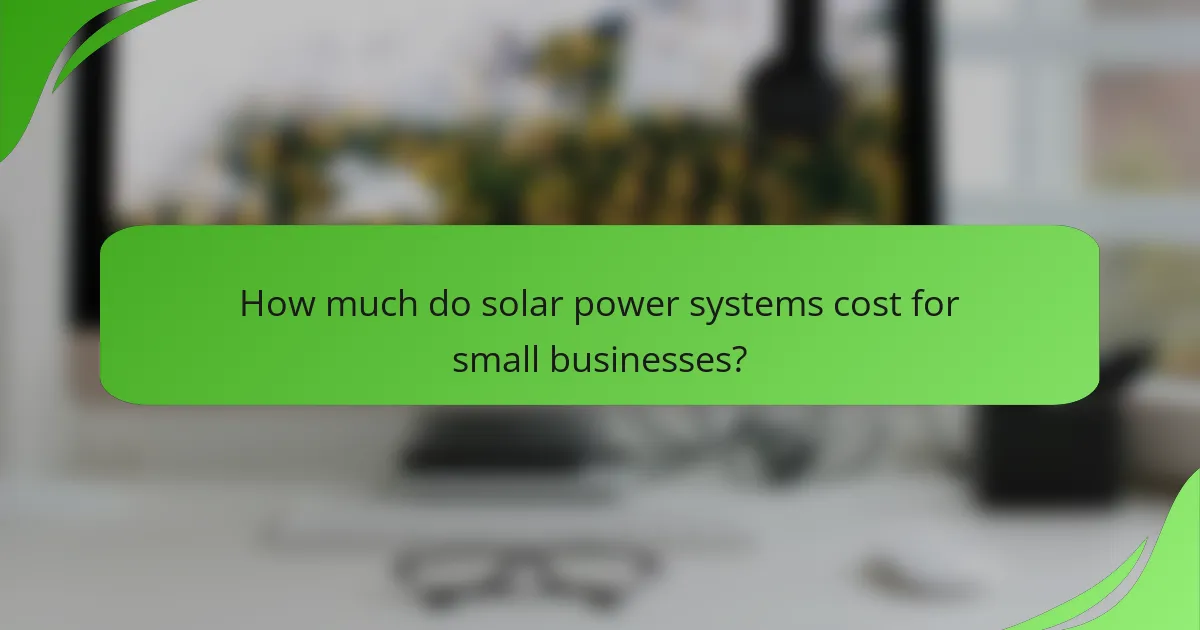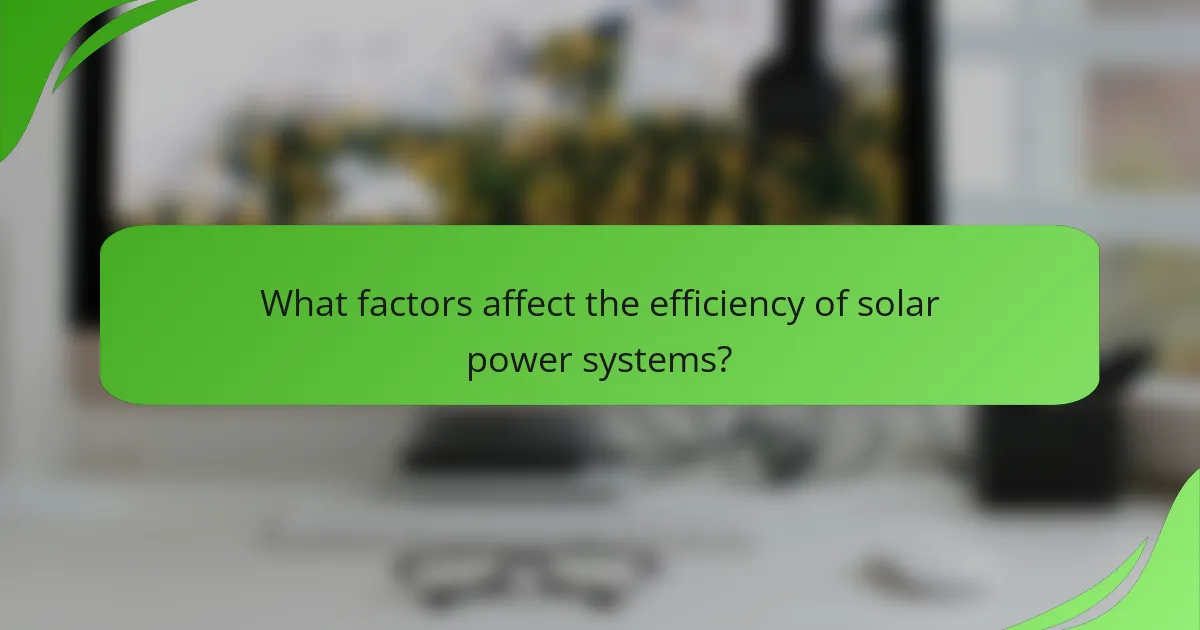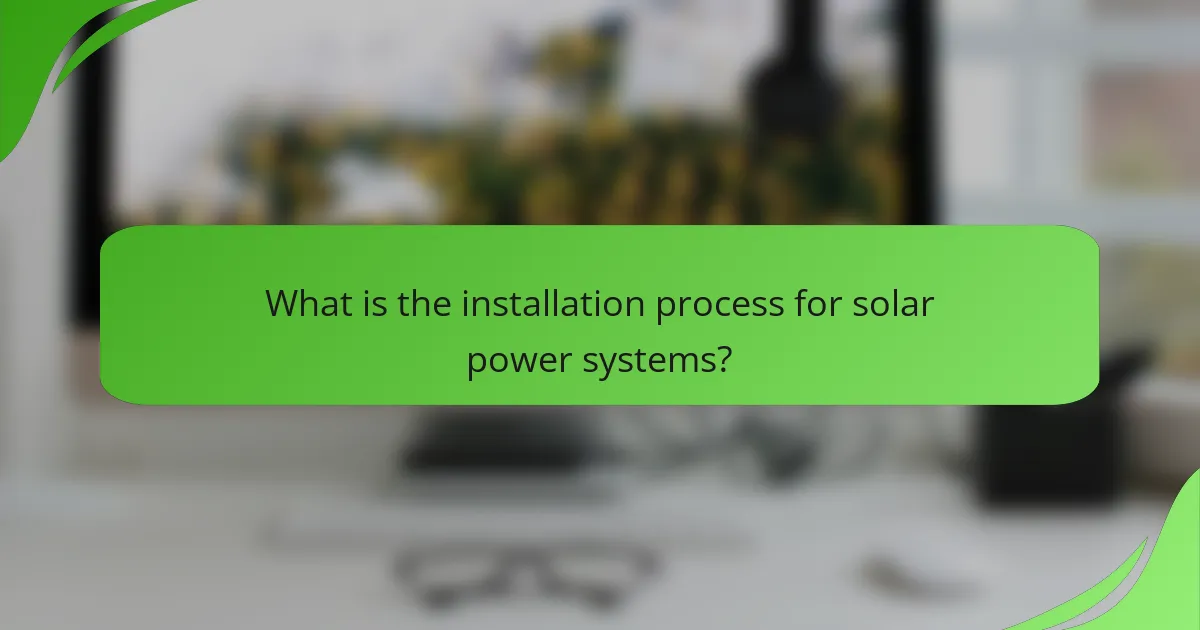Investing in solar power systems can be a game-changer for small businesses, offering sustainable energy solutions tailored to their unique needs. With options like grid-tied, off-grid, and hybrid systems, businesses can choose the best fit based on efficiency, cost, and installation requirements. Understanding factors such as system size, location, and available incentives is crucial for maximizing the benefits of solar energy.

What are the best solar power systems for small businesses in the US?
The best solar power systems for small businesses in the US include grid-tied, off-grid, and hybrid systems. Each type has distinct advantages and considerations, allowing businesses to choose based on their energy needs, budget, and location.
Grid-tied solar systems
Grid-tied solar systems are connected to the local utility grid, allowing businesses to use solar energy while still having access to grid power. This setup is often the most cost-effective option, as it eliminates the need for expensive battery storage.
When considering a grid-tied system, businesses should evaluate their energy consumption patterns and local net metering policies. Many states offer incentives that can significantly reduce installation costs, making this option attractive for small enterprises.
Off-grid solar systems
Off-grid solar systems operate independently of the utility grid, providing complete energy autonomy. These systems are ideal for businesses located in remote areas or those looking to be self-sufficient.
However, off-grid systems require substantial upfront investment in battery storage to ensure a reliable power supply. Businesses should assess their energy needs carefully and consider potential maintenance costs associated with battery systems.
Hybrid solar systems
Hybrid solar systems combine elements of both grid-tied and off-grid systems, allowing businesses to utilize solar energy while having backup battery storage. This flexibility can be beneficial during power outages or peak demand times.
When choosing a hybrid system, businesses should weigh the costs of installation and maintenance against the potential savings on energy bills. Hybrid systems can be more expensive upfront but may offer long-term savings and energy security.

How much do solar power systems cost for small businesses?
The cost of solar power systems for small businesses typically ranges from several thousand to tens of thousands of dollars, depending on system size and installation specifics. Factors such as location, energy needs, and available incentives can significantly influence the final price.
Average installation costs
Installation costs for solar power systems can vary widely, generally falling between $15,000 and $40,000 for small businesses. This range includes equipment, labor, and any necessary permits. The total cost is often determined by the size of the system, with larger systems requiring more investment but potentially offering greater savings over time.
It’s essential to obtain multiple quotes from local installers to ensure competitive pricing and quality service. Additionally, consider the long-term savings on energy bills when evaluating upfront costs.
Financing options available
Small businesses have several financing options to consider when investing in solar power systems. Common choices include solar loans, leases, and power purchase agreements (PPAs). Solar loans allow businesses to own the system outright, while leases and PPAs provide a way to pay for solar energy without upfront costs.
Many financial institutions and solar companies offer tailored financing solutions, so it’s advisable to compare terms and interest rates to find the best fit for your budget and cash flow.
Tax incentives and rebates
Tax incentives and rebates can significantly reduce the overall cost of solar power systems for small businesses. In the United States, the federal solar investment tax credit (ITC) allows businesses to deduct a substantial percentage of the installation costs from their federal taxes. Many states and local governments also offer additional incentives, such as cash rebates or property tax exemptions.
To maximize savings, research available incentives in your area and consult with a tax professional to understand how they apply to your specific situation. Staying informed about changing regulations can also help you take advantage of new opportunities as they arise.

What factors affect the efficiency of solar power systems?
The efficiency of solar power systems is influenced by several key factors including the type of solar panels used, their installation angle and orientation, and the location’s sunlight exposure. Understanding these elements can help small businesses optimize their solar energy systems for better performance and cost-effectiveness.
Panel type and technology
The type of solar panels significantly impacts efficiency. Monocrystalline panels generally offer higher efficiency rates, often exceeding 20%, while polycrystalline panels might range from 15% to 20%. Thin-film panels, although less efficient, can be more flexible and lighter, making them suitable for specific applications.
When selecting panels, consider the technology used. Higher efficiency panels may have a higher upfront cost but can yield better long-term savings. Look for panels that meet industry standards, such as those certified by the International Electrotechnical Commission (IEC).
Installation angle and orientation
The angle and orientation of solar panels play a crucial role in maximizing sunlight exposure. Ideally, panels should be installed at an angle that matches the latitude of the location, typically between 30 to 45 degrees in many regions. South-facing installations generally capture the most sunlight throughout the day.
Improper installation can lead to significant efficiency losses. Avoid shading from nearby trees or buildings, and consider adjustable mounts that allow for seasonal angle changes to optimize energy capture.
Location and sunlight exposure
The geographical location directly affects the amount of sunlight a solar power system receives. Areas with high solar irradiance, such as the southwestern United States, can produce significantly more energy than regions with frequent cloud cover or higher latitudes.
When assessing location, evaluate local weather patterns and seasonal variations in sunlight. Tools like solar maps can help estimate potential energy production based on historical data. Small businesses should also check local regulations and incentives that may impact solar installation and efficiency.

What is the installation process for solar power systems?
The installation process for solar power systems involves several key steps, from initial site assessment to final connection. Understanding these steps helps small business owners prepare for a smooth installation and maximize their solar investment.
Site assessment steps
The site assessment is crucial for determining the feasibility and efficiency of a solar power system. This typically involves evaluating the roof’s orientation, shading from nearby structures, and structural integrity. A professional installer will conduct a detailed analysis to ensure the system can generate optimal energy.
During the assessment, factors such as local climate conditions and energy consumption patterns are also considered. This information helps in designing a system that meets the specific energy needs of the business.
Permitting requirements
Before installation, obtaining the necessary permits is essential. These requirements can vary significantly by location, often depending on local regulations and building codes. Small businesses should check with local authorities to understand what permits are needed for solar installations.
Common permits include zoning permits, electrical permits, and building permits. Engaging with a knowledgeable installer can simplify this process, as they often handle permit applications on behalf of the business owner.
Installation timeline
The installation timeline for solar power systems can range from a few weeks to several months, depending on various factors. After permits are secured, the actual installation usually takes a few days to complete. However, delays can occur due to weather conditions or supply chain issues.
It’s advisable for small businesses to plan for potential delays and communicate with their installer about the expected timeline. This proactive approach helps ensure that the business is prepared for the transition to solar energy without significant disruptions.

What are the benefits of solar power for small businesses?
Solar power offers numerous advantages for small businesses, including significant cost savings, reduced environmental impact, and increased energy independence. By harnessing the sun’s energy, businesses can lower their operational costs while contributing to a sustainable future.
Cost savings on energy bills
Implementing solar power can lead to substantial reductions in energy expenses. Many small businesses experience savings of 20% to 50% on their electricity bills after installing solar systems. This translates to thousands of dollars saved annually, depending on energy consumption and local utility rates.
Additionally, various incentives, such as tax credits and rebates, can further decrease the initial investment. For instance, in the United States, the federal solar tax credit allows businesses to deduct a significant percentage of the installation costs from their federal taxes.
Environmental impact reduction
Switching to solar energy significantly lowers a business’s carbon footprint. By utilizing renewable energy, companies can reduce greenhouse gas emissions associated with traditional fossil fuels. This shift not only benefits the environment but can also enhance a business’s reputation among eco-conscious consumers.
Moreover, many regions offer sustainability certifications for businesses that adopt green practices, which can attract new customers and improve brand loyalty. Engaging in solar energy initiatives demonstrates a commitment to environmental stewardship, which is increasingly valued in today’s market.
Energy independence
Solar power provides small businesses with greater energy independence by reducing reliance on grid electricity. This autonomy can protect businesses from fluctuating energy prices and supply disruptions. With a solar system, companies can generate their own power, ensuring a more stable energy source.
Furthermore, integrating battery storage solutions allows businesses to store excess energy for use during peak demand times or outages. This capability enhances resilience and can lead to additional savings by avoiding high utility rates during peak hours.

How do small businesses choose the right solar power system?
Small businesses can choose the right solar power system by assessing their energy needs, budget, and installation options. Understanding these factors helps in selecting a system that maximizes efficiency and cost-effectiveness.
Evaluating energy needs
To evaluate energy needs, small businesses should start by analyzing their current electricity consumption. This involves reviewing utility bills for the past year to determine average monthly usage, typically measured in kilowatt-hours (kWh).
Next, consider future energy requirements, especially if the business plans to expand or add new equipment. A good rule of thumb is to account for a potential increase of 10-20% in energy needs over the next few years.
Once you have a clear picture of energy consumption, you can estimate the size of the solar power system required. Generally, a system should produce enough energy to cover at least 80-100% of your monthly usage to maximize savings and efficiency.
